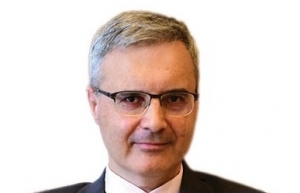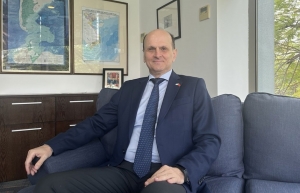Vietnam’s economy steadfast amid the headwinds
Global economic prospects have worsened. Inflation continues to accelerate in most economies on high global energy and food prices. Global oil, gas, and food prices have come down from their peaks earlier this year but remain higher than in early 2022. Tightening monetary and financial conditions will continue to drag on economic activity in the United States and the Eurozone in 2023, with the latter likely to experience a technical recession.
 |
| Andrew Jeffries, Country director for Vietnam Asian Development Bank |
Developing Asia’s recovery is expected to continue but lose some steam. Headline inflation in developing Asia stood at 5.6 per cent in September, up from 3 per cent at the start of the year, reflecting a consistently upward trend across the region’s economies.
Central banks continue to raise policy rates to curb inflation and safeguard financial stability. This has tightened financial conditions in the region, which have also been greatly influenced by aggressive rate hikes in the US and Europe.
The Asian Development Bank has revised down 2022 GDP growth in developing Asia marginally to 4.2 per cent, reflecting downward revisions for East Asia and, particularly, in China, where pandemic-induced disruption and unresolved problems in the property market have weakened growth.
By contrast, the bank raised the economic growth forecast for Southeast Asia in 2022 up to 5.5 per cent thanks to higher forecasts for Malaysia, the Philippines, Thailand, Timor-Leste, and Vietnam after surprisingly robust performances in the last quarter due to stronger consumption, trade and services, and tourism.
In Vietnam, economic activities recovered faster than expected following the removal of pandemic restrictions and the achievement of nationwide vaccine coverage. A strong performance across sectors boosted the country’s economy, and growth rebounded to 8.8 per cent in the first three quarters and continued to expand by the end of 2022.
Exports grew at 13 per cent on-year, and imports grew at 10 per cent on-year, making a trade surplus of $10.6 billion in the first 11 months of last year. Disbursements of foreign direct investment remained strong, increasing by 7.8 per cent on-year, estimated at $7.7 billion, the highest disbursement in five years.
Normalised mobility boosted domestic tourism, reaching nearly 100 million domestic visitors in the first eleven months of 2022, higher than the pre-pandemic period. The domestic consumption in November was up 2.6 per cent from the previous month and up 17.5 per cent over the same period last year.
As Vietnam’s GDP growth is strong, inflation and other factors affecting the economy are much less severe than in neighbouring countries. Vietnam’s public debt-to-GDP ratio was 43 per cent, which is relatively low, giving the country solid macroeconomic foundations.
Many other countries in the region are not holding up nearly as well as Vietnam to these global challenges and economic shocks. However, headwinds have been strengthening since the last quarter of 2022. Though trade continues to expand, key economic indicators have shown weakening global demand for the country’s exports.
The number of new orders is likely to drop early this year. Employment could also fall due to declining economic activities. Recent monetary tightening, irregularities in the corporate bond market and slow disbursement of public investment have tightened liquidity for economic recovery.
High inflation in the US and other advanced economies, though slightly abating in November, could prolong the current monetary tightening cycle. The appreciating US dollar resulted from the Fed’s monetary tightening, which could continue to put depreciating pressure on the Vietnamese currency, creating inflationary pressure, and putting pressure on foreign reserves.
Growth deceleration in China will also impact Vietnam’s economic prospects in 2023. The worsening situation with Russia and Ukraine could renew surges in commodity prices, further stoking global inflation and inducing further monetary tightening. Against this background, our growth forecast for Vietnam in 2023 has been adjusted from 6.7 to 6.3 per cent.
Global inflation remains uncertain. Supply chain disruptions by continued geopolitical tensions and rising demand for energy from eased mobility restrictions in China could push up global commodity prices. The policy responses for Vietnam need to strike a dedicated balance between containing inflation and maintaining economic growth and, at the same time, ensuring stability in the financial sector.
In 2022, the government succeeded in managing flexible monetary policy and prudent fiscal policy to ensure macroeconomic stability. There should be greater and more efficient coordination between fiscal and monetary policy in 2023.
While monetary measures have tightened to stem imported inflation, targeted fiscal support is desirable to support businesses and strengthen social protection, given the increasing negative impact on the labour force due to the global economic downturn.
There are many reasons for optimism on Vietnam’s economic prospects in 2023. Looking forward, economic growth in 2022 was on par with pre-pandemic growth levels, despite a challenging global economic environment and a volatile stock market. Investment from overseas was strong and has even picked up. There is no doubt that Vietnam’s economic prospects for the medium and long term remain positive.
Foreign investors think long-term when they make their investments, and we noted that there is continued strong interest in Vietnam as a destination to place funding, which clearly shows a long-term vote of confidence in the country. With sound economic fundamentals and strong leadership, we strongly believe that Vietnam will be able to brace the headwinds of 2023 and beyond.
| Nobuyuki Matsumoto, Chief representative in Ho Chi Minh City Japan External Trade Organization
While many of the GDP growth forecasts for 2022 in neighbouring ASEAN countries were revised downward, Vietnam was revised upward in most cases. The recent ADB announcement was similarly revised upward to 7.5 per cent, and it is commendable that the growth forecast for 2023 remains high. Despite the positive macroeconomic outlook, it should be noted that there have been reports that approximately 40,000 people have been laid off, mainly in the sewing and wood processing industries, and that the electrical and electronics industry, which had been the driving force of Vietnam’s economy, is showing signs of slowing and uncertainty is increasing. Developing supporting industries and cultivating high-level industrial human resources are key to securing future growth. I hope the Vietnamese government will continue its efforts in this area. According to a survey of ours released in December, 59.5 per cent of companies (up over 5 per cent from the previous year) said that their operating income forecast for 2022 would be in the black, while 20.8 per cent (down almost 8 per cent) said they would be in the red. While this is slightly below average for Vietnam, given that the average for the Asia-Oceania region is 65.6 and 16.4 per cent, respectively, 53.6 per cent of firms indicated that their expected operating income in 2023 to improve, ranking second only to Laos in ASEAN. Although the speed at which the country is recovering from the impact of the pandemic is slower than in other countries, the results indicate that it is steadily improving. Regarding the direction of future business development, 60 per cent of companies (up nearly 5 per cent from the previous year) responded that they would expand, the third-highest percentage in the Asia-Oceania region after India and Bangladesh, and the highest in ASEAN. The percentage of companies that responded that they would downsize was 1.1 per cent, down slightly on last year. Looking at the breakdown of companies that said that they would expand, it is notable that the manufacturing, food, medicine, paper/wood, rubber/ceramics, and medical equipment segments were high, followed by education, medical care, agro-forestry-fisheries, real estate, retail, and mining/energy. The large increase in the willingness of small- and medium-sized enterprises in the non-manufacturing sector to expand is noteworthy. The survey results are only preliminary, and we plan to release a more detailed version in early February that will include China+1 movements. In addition to the trend of relocating production bases from China, recent relocation cases from Thailand, where labour costs are soaring, will combine to make Vietnam an attractive investment destination for Japanese investors in 2023. |
 | 50 years of French relations In 2023, France and Vietnam will celebrate the 50th anniversary of diplomatic relations and 10 years of strategic partnership. This is a good opportunity to look back and assess what our two countries have accomplished in trade and investment and reflect on ways to further develop our economic exchanges. |
 | Vietnam in 2023 - time to take off The economic and commercial relations between Denmark and Vietnam have expanded substantially. On the occasion of Lunar New Year, VIR’s Kim Oanh had an opportunity to speak with Nicolai Prytz, Danish Ambassador to Vietnam, about important milestones of trade-investment cooperation in recent times and the opportunities to promote bilateral cooperation. |
 | Much to celebrate with 50 years of Singaporean ties This year marks a momentous one for Singapore and Vietnam’s relationship, commemorating two key milestones. It marks 50 years since the establishment of diplomatic relations between Singapore and Vietnam and 10 years since the establishment of a strategic partnership between the two countries. |
 | Potential through the roof for bilateral advancement in UK-Vietnam linkages The United Kingdom and Vietnam’s relations are at an all-time high, and in that context, we are delighted to be celebrating five decades of diplomatic relations this year. The UK-Vietnam Strategic Partnership, refreshed in 2020 shortly after I arrived in the post, set the tone for an ever-closer political and economic relationship. |
 | Growing Argentinian ties In 2023, Argentina and Vietnam will celebrate the 50th anniversary of diplomatic relations. Twenty five years ago, the two countries opened their respective embassies in Buenos Aires and Hanoi. From that moment onwards, commercial cooperation has been one of the three pillars of the bilateral relationship, along with excellent political dialogue and technical cooperation. |
 | The path to faster growth in Australia-Vietnam relations As a newly arrived Ambassador in Vietnam, I have been busy meeting people, reading widely, and trying to understand this complex and fascinating country. |
 | Malaysia can forge further strategies with Vietnam Malaysia established diplomatic relations with the Vietnam on March 30, 1973 and both countries elevated their bilateral cooperation by signing a strategic partnership in 2015. This year marks the 50th anniversary of diplomatic relations, in which Malaysia is looking forward to deepening mutual understanding, trust, and growing cooperation between the two nations. |
What the stars mean:
★ Poor ★ ★ Promising ★★★ Good ★★★★ Very good ★★★★★ Exceptional
Related Contents
Latest News
More News
- Main drivers for Vietnam’s digital economy future (December 03, 2025 | 11:35)
- Pivotal stage of growth paves way for rise in M&As (December 03, 2025 | 10:00)
- Positive projections for M&A interest from Thailand (December 03, 2025 | 09:40)
- Manifesting the first line of defence in cybersecurity (December 03, 2025 | 09:00)
- The transformational role AI can play in accounting arena (December 03, 2025 | 08:00)
- Unlocking 5G-AI potential in Singapore (December 03, 2025 | 08:00)
- Data-driven strategies vital for a fast-evolving nation (December 02, 2025 | 09:41)
- Policy to practice: how Vietnam can lead the region (November 26, 2025 | 16:03)
- Mobilising private capital at scale vital for climate battle (November 26, 2025 | 15:36)
- VILAF and Yoon & Yang launch Vietnam - Korea Practice Unit (November 26, 2025 | 15:16)


 Tag:
Tag:




















 Mobile Version
Mobile Version